Lake Superior coaster brook trout
Fishing Wisconsin
Is the coaster brook trout a unique strain long lost from Wisconsin's Lake Superior shoreline...
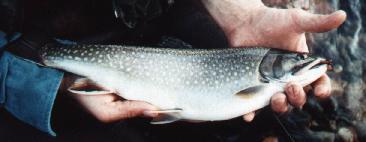
Brook trout displaying lake coloration
Wisconsin DNR Photo
or is it a stream source brook trout that simply grow faster when they spend time in the lake environment?
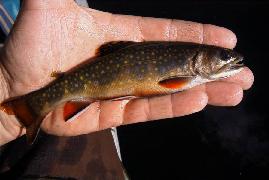
Brook trout displaying stream coloration
Wisconsin DNR Photo
Although once thought by most to be a unique brook trout strain the latest genetic research done in the Nipigon Bay region of Canada supports the theory that these fish are simply stream source brook trout. The study results said that: coasters come from tributary brook trout populations and just grow faster and reach larger sizes in the lake than their siblings that remain in streams. When coasters mature they return to the stream to spawn with their stream-dwelling brothers and sisters.
What was the historic coaster fishery like?
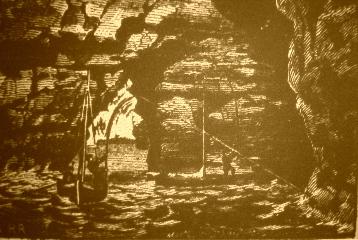
1879 Newspaper Drawing of Rock Trout Fishing.
Wisconsin DNR Photo
During the 1850s to 1870s large brook trout called a 'Rock Trout' (termed coaster's today) were sought along the rocky coastlines of the Bayfield Peninsula. They were named rock trout because they were angled in the fallen rocks at the base of the sandstone cliffs as depicted in this newspaper drawing from 1879.
Typical period lake catches consisted of brook trout averaging about a pound with large fish around three pounds. Occasional four-pound fish were noted. Anglers mainly fished live bait out of rowboats casting among the immediate shadows of the rocky cliffs during the months of June and July.
The coaster fishery shifted to deep holes within the lower ends of tributaries in August. Fish ascended to upstream spawning reaches during September and October. After spawning it is unknown when they returned to Lake Superior.
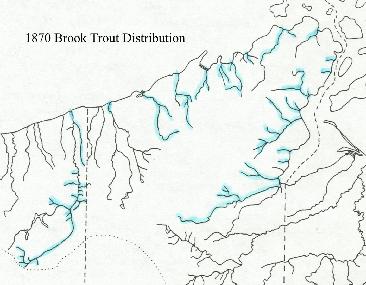
1870's Map of Coastal Brook Trout Streams.
Wisconsin DNR Photo
When did the coaster fishery decline and why?
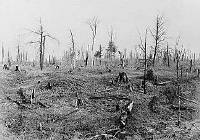
Wisconsin DNR Photo
The coaster brook trout fishery declined dramatically during the 1880s. We suspect that initial declines were caused mostly by commercial and angling over-harvest. But watershed changes that followed destroyed critical stream habitat which severely depressed both their abundance and chances for recovery.
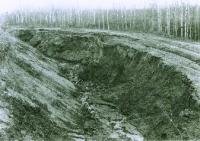
Wisconsin DNR Photo
Much of the damaging watershed impact included driving logs down streams, forest cut-over, forest fires, farmland drainage and road and railroad construction. These activities allowed a greater volume of water to quickly run off the landscape. Larger floods washed away and destroyed habitat that was both essential and critical to brook trout. As populations of stream brook trout declined fewer were able to reach lakeshore habitat and become coasters.
How has tributary habitat changed?

This photo shows what good tributary habitat used to look like.
Wisconsin DNR Photo
Tributary habitat has been severely damaged since the time coasters were common to the Bayfield Peninsula shoreline.
Historic stream channels contained large volumes of fallen trees like the photo to the right that once provided the "right stuff" to support large brook trout populations.
These logs protected critical spawning sites, provided cover and gave newly hatched fry protection from being washed away during flood events.
The illustration below on the left shows what good habitat for coaster brook trout should look like. The illustration below on the right shows what degraded habitat for coaster brook trout would look like.
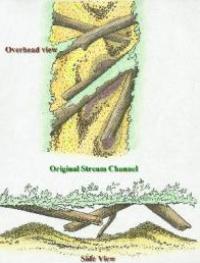
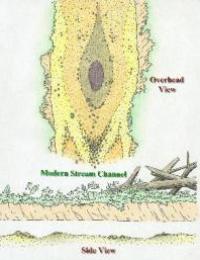
Wisconsin DNR Illustration
These habitat changes have resulted in fewer brook trout in our tributaries which equates to fewer coasters.
Dr. David Lonzarich (UW Eau Claire) is heading up a DNR funded project to study the differences between a well-wooded (more like the historic stream habitat) and an open section of the East Fork of the Cranberry River.
Historic brook trout stocking attempts
The angling public quickly requested brook trout stocking soon after the fishery began declining in the late 1880s. Millions of brook trout were stocked during the last century in Lake Superior and it's tributaries. Although stocked fish survived to be caught by anglers they failed to restore both a self-sustaining stream brook trout population and a coaster fishery. Stocking quickly switched to other more successful trout species (browns, rainbows) that were better adapted to reproducing in degraded stream habitats.
The last major effort to reestablish a coaster brook trout fishery occurred between 1982 to 1996 when a half-million Lake Nipigon, Ontario, strain brook trout were stocked. Despite stocking at different sizes, seasons, and locations, the program produced very poor returns to the creel and no documented natural reproduction. Recent research indicates degraded stream habitats are inhibiting brook trout recovery. Current management efforts have shifted from stocking to watershed rehabilitation.

Coaster Brook Trout fingerling.
Wisconsin DNR Photo
Present brook trout management
The Wisconsin Department of Natural Resources has spent the last 50 years protecting and improving the basin's brook trout populations. Examples of initiatives include:
- Land Acquisition - The Brule River State Forest and the South Shore Fish and Wildlife Area (includes Fish Creek, Sioux River, Pikes Creek, Cranberry and Flag Rivers) were established many years ago to acquire land along streams to protect stream banks and critical trout habitat.
- Angling Regulations - Established experimental 'no-kill' brook trout regulations on Graveyard Creek, Whittlesey Creek and the Bark River. In addition, a one bag twenty-inch minimum size limit was established on Lake Superior.
- Habitat Improvement - Projects are on-going to improve in-stream habitat and understand and improve watershed health (see photos below). Many of the past habitat improvement structures failed after flood events. Beaver Control - Beaver populations are controlled on tributary streams to protect critical spawning areas and ensure that lake run trout can reach their spawning areas.
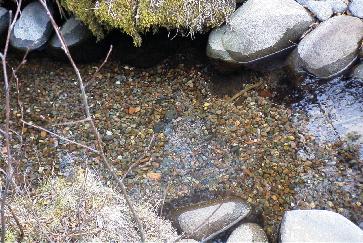
Brook trout spawning habitat improvement project.
Wisconsin DNR Photo
